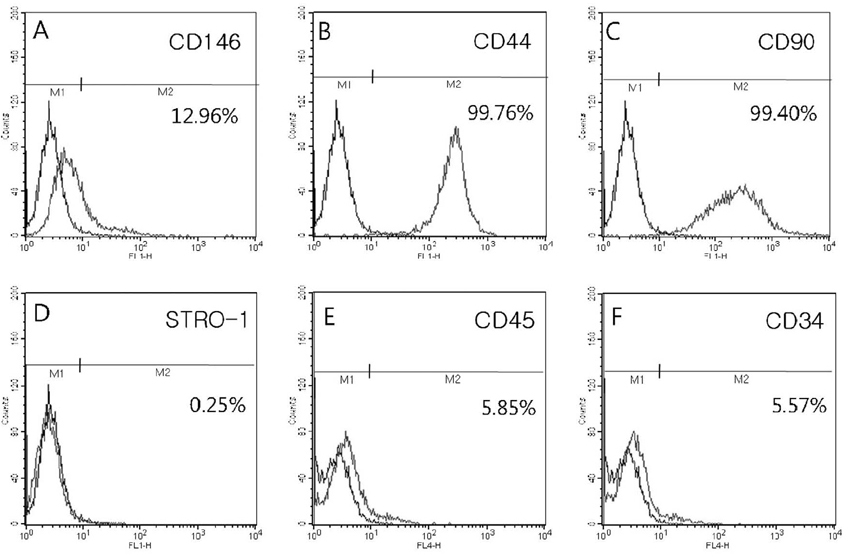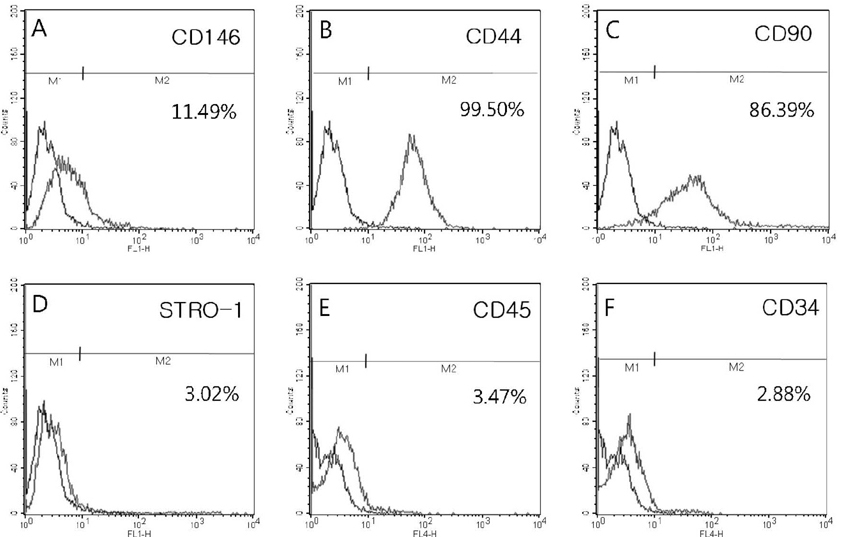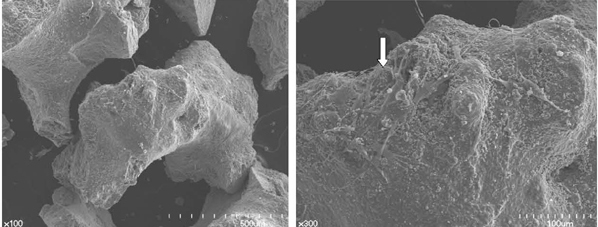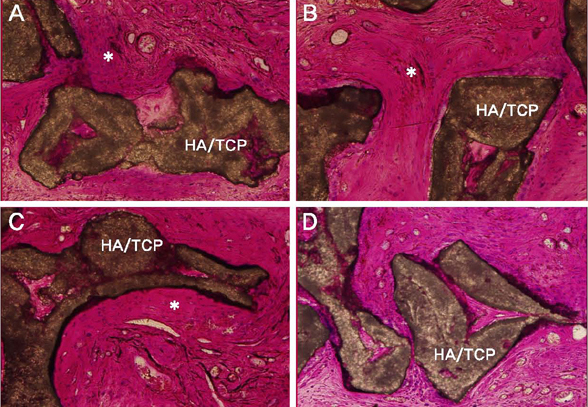J Korean Acad Periodontol.
2009 Jun;39(2):119-128. 10.5051/jkape.2009.39.2.119.
Investigation of postnatal stem cells from canine dental tissue and bone marrow
- Affiliations
-
- 1Department of Periodontology and Dental Research Institute, School of Dentistry, Seoul National University, Korea. lee@snu.ac.kr
- 2Department of Dentistry, Hanil General Hospital, Korea.
- 3Department of Periodontics, Asan Medical Center, Korea.
- KMID: 1733729
- DOI: http://doi.org/10.5051/jkape.2009.39.2.119
Abstract
-
PURPOSE: The aim of this study was to evaluate the stemness of cells from canine dental tissues and bone marrow.
METHODS
Canine periodontal ligament stem cells (PDLSC), alveolar bone stem cells (ABSC) and bone marrow stem cells(BMSC) were isolated and cultured. Cell differentiations (osteogenic, adipogenic and chondrogenic) and surface antigens (CD146, STRO-1, CD44, CD90, CD45, CD34) were evaluated in vitro. The cells were transplanted into the subcutaneous space of nude mice to assess capacity for ectopic bone formation at 8 weeks after implantation.
RESULTS
PDLSC, ABSC and BMSC differentiated into osteoblasts, adipocytes and chondrocytes under defined condition. The cells expressed the mesenchymal stem cell markers differently. When transplanted into athymic nude mice, these three kinds of cells with hydroxyapatite /beta tricalcium phosphate (HA/TCP) carrier showed ectopic bone formation.
CONCLUSIONS
This study demonstrated that canine dental stem cells have stemness like bone marrow stem cells. Transplantation of these cells might be used as a therapeutic approach for dental stem cell-mediated periodontal tissue regeneration.
MeSH Terms
Figure
Cited by 2 articles
-
Immunomodulatory effect of canine periodontal ligament stem cells on allogenic and xenogenic peripheral blood mononuclear cells
Hak-Sung Kim, Kyoung-Hwa Kim, Su-Hwan Kim, Young-Sung Kim, Ki-Tae Koo, Tae-Il Kim, Yang-Jo Seol, Young Ku, In-Chul Rhyu, Chong-Pyoung Chung, Yong-Moo Lee
J Periodontal Implant Sci. 2010;40(6):265-270. doi: 10.5051/jpis.2010.40.6.265.Gene expression profile in mesenchymal stem cells derived from dental tissues and bone marrow
Su-Hwan Kim, Young-Sung Kim, Su-Yeon Lee, Kyoung-Hwa Kim, Yong-Moo Lee, Won-Kyung Kim, Young-Kyoo Lee
J Periodontal Implant Sci. 2011;41(4):192-200. doi: 10.5051/jpis.2011.41.4.192.
Reference
-
1. Cai J, Weiss ML, Rao MS. In search of "stemness". Exp Hematol. 2004; 32:585–598.
Article2. Wagers AJ, Weissman IL. Plasticity of adult stem cells. Cell. 2004; 116:639–648.
Article3. Bianco P, Robey PG. Stem cells in tissue engineering. Nature. 2001; 414:118–121.
Article4. Fuchs E, Tumbar T, Guasch G. Socializing with the neighbors: stem cells and their niche. Cell. 2004; 116:769–778.5. Yin T, Li L. The stem cell niches in bone. J Clin Invest. 2006; 116:1195–1201.
Article6. Bruder SP, Kraus KH, Goldberg VM, Kadiyala S. The effect of implants loaded with autogenous mesenchymal stem cells on the healing of canine segmental bone defects. J Bone Joint Surg Am. 1998; 80:985–996.7. Caplan AI. Mesenchymal stem cells: cell-based reconstructive therapy in orthopedics. Tissue Engineering. 2005; 11:1198–1211.
Article8. Kawaguchi H, Hirachi A, Hasegawa N, et al. Enhancement of periodontal tissue regeneration by transplantation of bone marrow mesenchymal stem cells. J Periodontol. 2004; 75:1281–1287.
Article9. Seo BM, Miura M, Gronthos S, et al. Investigation of multipotent postnatal stem cells from human periodontal ligament. Lancet. 2004; 364:149–155.
Article10. Matsunara T, Suardita K, Ishii M, et al. Alveolar bone marrow as a cell source for regenerative medicine: differences between alveolar and Iliac bone marrow stromal cells. J Bone Miner Res. 2005; 20:399–409.
Article11. Liu Y, Zheng Y, Ding G, et al. Periodontal ligament stem cell-mediated treatment for periodontitis in miniature swine. Stem Cells. 2008; 26:1065–1073.
Article12. Kim KH, Kim SH, Seol YJ, Lee YM. Stem cell properties of cells derived from canine periodontal ligament. J Korean Acad Periodontol. 2007; 37:479–488.
Article13. Bruder SP, Horowitz MC, Mosca JD, Haynesworth SE. Monoclonal antibodies reactive with human osteogenic cell surface antigens. Bone. 1997; 21:225–235.
Article14. Tsutsumi S, Shimazu A, Miyazaki K, et al. Retention of multilineage differentiation potential of mesenchymal cells during proliferation in response to FGF. Biochem Biophys Res Commun. 2001; 288:413–419.
Article15. Nagatomo K, Komaki M, Sekiya I, et al. Stem cell properties of human periodontal ligament cells. J Periodontal Res. 2006; 41:303–310.
Article16. Inoue T, Deporter DA, Melcher AH. Induction of chondrogenesis in muscle, skin, bone marrow, and periodontal ligament by demineralized dentin and bone matrix in vivo and in vitro. J Dent Res. 1986; 65:12–22.
Article17. Jo YY, Lee HJ, Kook SY, et al. Isolation and characterization of postnatal stem cells from human dental tissues. Tissue Engineering. 2007; 13:767–773.
Article18. Singhatanadgit W, Donos N, Olsen I. Isolation and characterization of stem cell clones from adult human ligament. Tissue Eng Part A. 2009; [Epub ahead of print].
Article19. Ivanovski S, Gronthos S, Shi S, Bartold PM. Stem cells in the periodontal ligament. Oral Diseases. 2006; 12:358–363.
Article20. Lee YM, Seol YJ, Lim YT, et al. Tissue-engineered growth of bone by marrow cell transplantation using porous calcium metaphosphate matrices. J Biomed Mater Res. 2001; 54:216–223.
Article21. Park DJ, Choi BH, Zhu SJ, et al. Injectable bone using chitosan-alginate gel/mesenchymal stem cells/BMP-2 composites. Journal of Cranio-Maxillofacial Surgery. 2005; 33:50–54.
Article22. Hasegawa N, Kawaguchi H, Hirachi A, et al. Behavior of transplanted bone marrow-derived mesenchymal stem cells in periodontal defects. J Periodontol. 2006; 77:1003–1007.
Article
- Full Text Links
- Actions
-
Cited
- CITED
-
- Close
- Share
- Similar articles
-
- Differentiation of adult canine bone marrow stem cells into neurons
- Immunomodulatory effect of canine periodontal ligament stem cells on allogenic and xenogenic peripheral blood mononuclear cells
- Bone Marrow-Derived Mesenchymal Stem Cells for Regenerative Medicine
- Bone marrow-derived stem cells contribute to regeneration of the endometrium
- Chondrogenesis of Mesenchymal Stem Cell Derived from Canine Adipose Tissue










